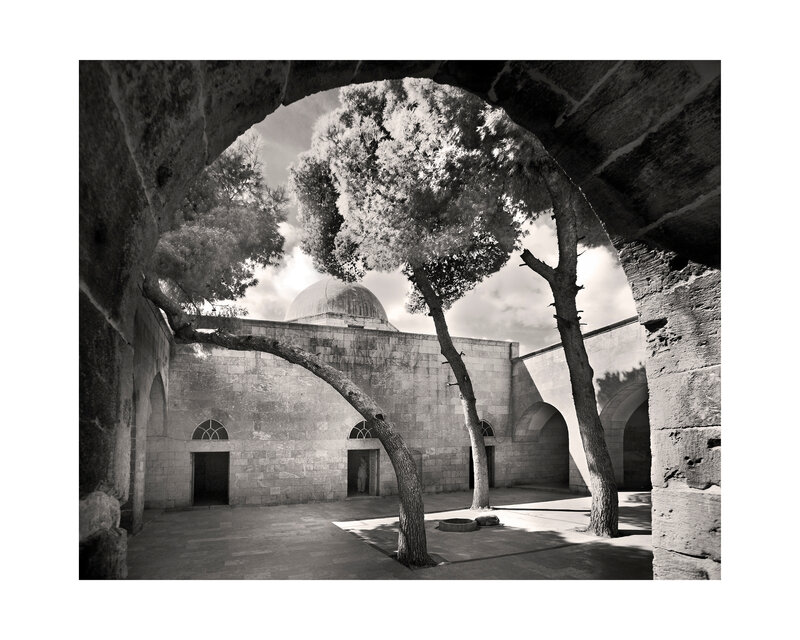Peter Aaron's photographs show a lost Syria
Peter Aaron, “Tetrapylon, Palmyra,” 2009. 16 x 20 inches.
ATHENS, GA.- In 2009, while on a family trip to Syria, architectural photographer Peter Aaron shot dozens of images of historic sites. Two years later, as part of the Arab Spring uprisings, protesters demanded that Syrian president Bashar al-Assad step down. Their violent suppression began a civil war that has continued to the present day and resulted in the destruction of many of the sites Aaron photographed. Despite intervention from foreign powers and the United Nations, the war continues to power on, causing the displacement of millions of citizens and a shocking death toll that had reached nearly half a million people as of 2016. “Before the War: Photographs of Syria by Peter Aaron” is on display at the Georgia Museum of Art at the University of Georgia from August 31 through December 1, 2019.
Over thousands of years, countless cultures have fought over Syria, with the victors building massive architectural structures. For example, the Temple of Bel originally provided a place to worship a Mesopotamian god. It was closed when the Roman Empire occupied Syria, converted to a Christian church during the Byzantine era, then became a mosque in the 12th century. Combining classical Greco-Roman and Near Eastern architecture, it stood for almost 2000 years but was destroyed by the Islamic State of Iraq and the Levant (ISIL, also known as ISIS) in 2015. Aaron’s black-and-white photographs of these buildings show the country’s complex sense of collective identity. Now, they remind us of what has been and continues to be lost to this war.
Peter Aaron, “Assad Pasha Khan, Damascus,” 2009. 40 x 30 inches.
His photographs in this exhibition capture the multicultural cities of Damascus, Aleppo and Palmyra, where ancient architecture from millennia of different civilizations encompasses contemporary activity. Syria has religious and civic monuments constructed by Jewish, Christian, Islamic, Roman and Ottoman peoples as well as others. In Aaron’s prints, the architecture left behind by these contrasting cultures appears to coexist cordially.
Upon visiting with a Syrian youth on their travels, the Aaron family was told, “If there were ever to be a rebellion against Bashar al-Assad, it would be a complete catastrophe, an apocalypse. There are so many warring factions that there would be no end to it.” Unfortunately, this catastrophe became a reality.
Peter Aaron, “Church of St. Simeon Stylites,” 2009. 30 x 40 inches.
Aaron’s photograph of the Tetrapylon at Palmyra shows an intact platform built by the Romans in the 2nd century CE. A few years ago, ISIL intentionally demolished the ancient monument with explosives. Several other architectural monuments that have stood for centuries or longer have been damaged both intentionally and collaterally by the devastating war. Today, Aaron’s peaceful pictures testify to past and chillingly remind us of how quickly art and life can be destroyed by violence.
Aaron’s work has been exhibited at the 2018 Venice Architecture Biennale and at the Center for Architecture in New York and written about in the New Yorker, Time, Architectural Digest, the Architect’s Newspaper and the Magazine Antiques.
Peter Aaron, “Court of the Mosque of Abraham, Aleppo Citadel,” 2009. 30 x 40 inches.
Peter Aaron, “Krac de Chevaliers,” 2009. 16 x 20 inches.
Peter Aaron, “Temple of Bel, Palmyra,” 2009. 16 x 20 inches.

/https%3A%2F%2Fprofilepics.canalblog.com%2Fprofilepics%2F1%2F0%2F100183.jpg)
/https%3A%2F%2Fstorage.canalblog.com%2F03%2F02%2F119589%2F96711876_o.jpg)
/https%3A%2F%2Fstorage.canalblog.com%2F11%2F31%2F119589%2F94773502_o.jpg)
/https%3A%2F%2Fstorage.canalblog.com%2F20%2F83%2F119589%2F94772815_o.jpg)
/https%3A%2F%2Fstorage.canalblog.com%2F26%2F72%2F119589%2F75604929_o.jpg)
/https%3A%2F%2Fstorage.canalblog.com%2F59%2F60%2F119589%2F26458628_o.jpg)








/image%2F1371349%2F20240418%2Fob_ac5c4c_telechargement.jpg)
/image%2F1371349%2F20240418%2Fob_709b64_304-1.jpg)
/image%2F1371349%2F20240418%2Fob_22f67e_303-1.jpg)
/image%2F1371349%2F20240417%2Fob_9708e8_telechargement.jpg)